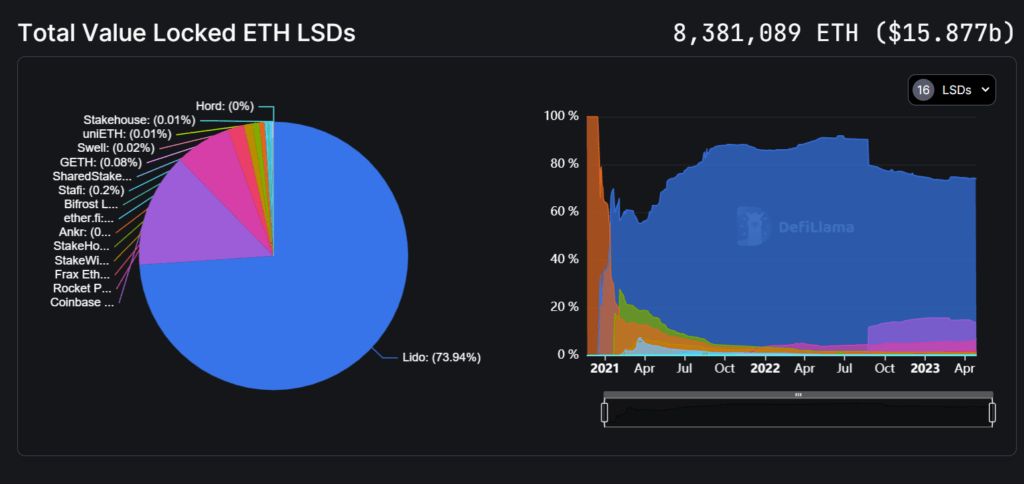Table of Contents
- What is Liquidity Staking?
- How does Liquidity Staking Work?
- Advantages of Liquidity Staking
- Disadvantages of Liquidity Staking
- Top 5 LSD Crypto
- Conclusion
Table of Contents
Toggle1. What is Liquidity Staking?
It is a method that allows users to earn rewards by supplying their cryptocurrency assets to a decentralized exchange or lending platform, making their assets available for trading or lending activities. This process involves depositing your cryptocurrency into a liquidity pool, which is a pool of tokens that is used to facilitate trades on a particular cryptocurrency exchange. In return, you earn rewards, such as transaction fees, from the exchange.
2. How does LSD Work?

LSD is a process that allows users to earn rewards by providing liquidity to a decentralized exchange or lending platform. In this process, users provide their cryptocurrency assets to a liquidity pool, which is used to facilitate trading and lending activities on the platform.
In return for providing liquidity, users are given tokens that represent their share of the liquidity pool. These tokens can be used to claim a portion of the fees generated by the platform or to vote on platform governance decisions.
The amount of rewards earned through liquidity staking depends on several factors, such as the amount of liquidity provided, the duration of the staking period, and the market conditions at the time. Generally, the longer the staking period and the more liquidity provided, the higher the rewards will be.
However, there are also risks associated with LSD. One major risk is the potential for impermanent loss, which occurs when the price of the cryptocurrency assets in the liquidity pool changes relative to each other. This can lead to a loss of value for the staked assets compared to holding them in a wallet.
Overall, LSD is a complex process that requires careful consideration of the risks and rewards involved. It can be a lucrative investment opportunity for those willing to do their research and invest wisely, but it’s important to approach liquidity staking with caution and an understanding of the underlying mechanisms.
3. Advantages of LSD
There are several advantages to LSD. Firstly, liquidity staking is an excellent way to earn passive income. Secondly, it is a low-risk investment as you are providing liquidity to an established cryptocurrency exchange. Thirdly, liquidity staking is a great way to earn rewards without the need for active trading.
4. Disadvantages of LSD
Although liquidity staking has many advantages, there are also some disadvantages. Firstly, the rewards for liquidity staking may not be significant enough to justify the risk. Secondly, the rewards may be affected by market volatility, which can be unpredictable. Thirdly, there may be liquidity risks associated with liquidity staking, which may affect the number of rewards earned.
5. Top 5 LSD Crypto
Liquidity staking has become increasingly popular in the world of cryptocurrency, and many investors are looking for the best LSD (Liquidity Staking Decentralized) coins to invest in. Here are more details on the top 5 LSD crypto mentioned in this article:

- Uniswap (UNI)
Uniswap is a popular decentralized exchange that provides users with a peer-to-peer platform for trading cryptocurrencies in a secure and trustless manner, without the need for a centralized intermediary. UNI is the native token of the Uniswap exchange and is used for governance and LSD. Uniswap is one of the most popular decentralized exchanges, and its liquidity pool offers significant rewards for stakers.
- Aave (AAVE)
Aave stands out as a leading decentralized lending platform that offers users the opportunity to borrow and lend cryptocurrencies on a global scale, in a secure, transparent and automated manner. AAVE is the native token of the Aave platform and is used for governance and LSD. Aave is one of the most popular DeFi platforms, and it offers attractive rewards for liquidity stakers.
- SushiSwap (SUSHI)
SushiSwap is a decentralized exchange that has been gaining popularity among cryptocurrency traders due to its innovative features and user-friendly interface, allowing users to trade cryptocurrencies without the need for an intermediary. SUSHI is the native token of the SushiSwap exchange and is used for governance and LSD. SushiSwap is a popular alternative to Uniswap, and its liquidity pool offers significant rewards for stakers.
- Curve (CRV)
Curve is a decentralized exchange that enables users to trade stablecoins. CRV is the native token of the Curve exchange and is used for governance and LSD. Curve’s liquidity pool offers significant rewards for stakers, and its focus on stablecoins makes it a popular choice for investors looking for lower-risk investments.
- Balancer (BAL)
Balancer is a unique decentralized exchange that not only allows users to trade cryptocurrencies, but also provides liquidity providers with a customizable and programmable platform that enables them to earn fees and manage their portfolio in a more efficient way. BAL is the native token of the Balancer exchange and is used for governance and LSD. Balancer’s liquidity pool offers significant rewards for stakers, and its innovative approach to token weighting makes it an attractive option for investors looking for greater control over their portfolios.
6. Conclusion
Liquidity staking can be a lucrative investment opportunity for cryptocurrency investors, but it’s important to weigh the advantages and disadvantages before jumping in. While LSD offers attractive rewards and requires little active involvement, there are also risks associated with market volatility and liquidity risks. However, for those willing to do their research and invest wisely, liquidity staking can be a great way to earn passive income and diversify their portfolios. Whether or not to participate in liquidity staking is a personal decision that should be based on a variety of factors, such as the investor’s financial goals, time horizon, risk appetite, and market conditions. By carefully evaluating these factors, investors can determine whether liquidity staking aligns with their investment strategy and risk tolerance.
